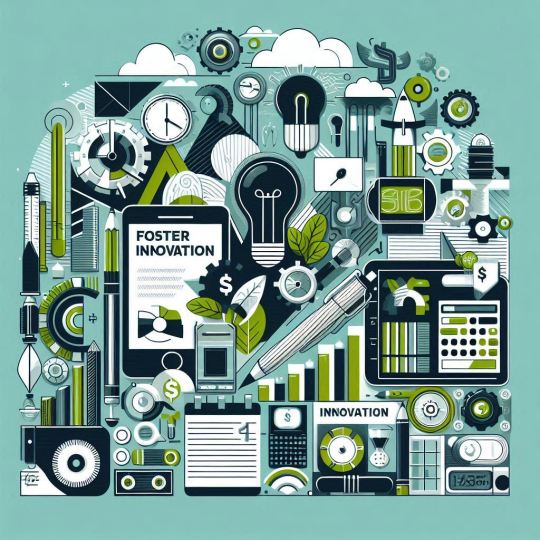#Business Strategy with AI
Explore tagged Tumblr posts
Text
Summary: 8 Key Steps to Successfully Launch an AI-Powered Business
In 8 Vital Steps to Take Before Launching an Artificial Intelligence-Powered Business for Success, the article outlines essential strategies and considerations for entrepreneurs looking to harness the power of artificial intelligence (AI) to create a thriving business. With AI technology transforming industries, this guide helps you navigate the critical phases of setting up a business driven by AI, ensuring that your launch is not only successful but sustainable.
The article covers key topics, including understanding AI’s potential for your specific business model, selecting the right technology, and building a skilled team to implement AI solutions. It also highlights the importance of data privacy, regulatory compliance, and ethical considerations in AI. These foundational steps ensure that your business is positioned for long-term success while maintaining a competitive edge in an ever-evolving market.
For more insights on emerging technologies and trends, explore Amaranth Magazine’s Tech Trends section, where we feature articles on the latest innovations in technology and how businesses can leverage them to stay ahead of the curve.
Artificial intelligence is revolutionizing industries from healthcare to finance, and knowing how to integrate AI effectively into your business strategy can make all the difference. This article provides actionable advice for every stage, from conceptualization to launch, helping entrepreneurs turn AI ideas into successful business models.
For entrepreneurs interested in the intersection of business and technology, our Business Beat section offers additional articles on how digital transformation and new technologies are shaping the future of work.
Discover More about Amaranth Magazine: At Amaranth Magazine, we’re dedicated to providing entrepreneurs and innovators with the tools they need to succeed. Our articles explore a wide range of topics, from AI-powered business strategies to mindfulness and wellness. Visit Amaranth Magazine for in-depth articles on how technology and trends are reshaping industries.
For those looking for more information on how to manage change in your business or gain insights into future tech, check out our Business Beat section for expert advice and strategies for navigating the modern business landscape.
Connect and Engage: Stay updated on the latest articles, tips, and success stories by subscribing to Amaranth Magazine’s newsletter. Visit our Subscription page to get new content directly to your inbox.
If you have valuable insights or stories to share about AI and technology, we invite you to contribute to our platform. Visit our Contribute Your Content page to learn how you can share your expertise with our readers.
For businesses interested in reaching an engaged audience of entrepreneurs and tech enthusiasts, explore our Amaranth Advertising Portal and review our Advertising Policy.
More Resources: At Amaranth Magazine, we value your privacy. To understand how we protect your information, please refer to our Privacy Policy.
Explore our Archive of Amaranth Magazine for past articles on technology, business, and other exciting topics.
Call to Action: Before launching your AI-powered business, make sure you’re equipped with the essential knowledge to succeed. To read the full article and discover more on how to integrate AI into your business strategy, visit the Tech Trends section at Amaranth Magazine.

#AI-Powered Business#Artificial Intelligence for Entrepreneurs#Tech Startups and AI#Business Strategy with AI#Amaranth Magazine Technology Insights
2 notes
·
View notes
Text

As businesses, we know that providing exceptional #customerservice is crucial to building strong relationships & driving growth. But, are you using the right strategies to deliver #omnichannel customer service? Discover the benefits of omnichannel customer service, including increased #customersatisfaction, loyalty, & retention.
Check out our blog post to learn how: https://www.vitelglobal.com/blog/omnichannel-customer-service/
#CustomerService#CustomerExperience#Business#technology#omnichannelmarketing#digital#ai#digitaltransformation#contactcenter#chatbot#innovation#businessstrategy#cloud#multichannel#strategy
7 notes
·
View notes
Text
How to become a great creative director?
Being a great creative director requires a mix of leadership, vision, and adaptability. Here are some key qualities and strategies to help you excel in this role:
1. Develop a Clear Vision
- Establish a strong creative vision that aligns with the brand’s goals and values. This will provide direction for your team and guide decision-making.
- Communicate your vision clearly to your team, clients, and stakeholders. Make sure everyone understands the goals and objectives.
2. Cultivate Your Creativity and Stay Inspired
- Stay up-to-date with design trends, art, technology, and cultural movements. Regularly consume content outside of your field to broaden your perspective.
- Encourage a culture of experimentation and exploration. Great ideas often come from unexpected places, so be open to unconventional sources of inspiration.
3. Empower and Trust Your Team
- Hire skilled, diverse team members and give them the freedom to bring their ideas to the table. Trust their expertise and let them take ownership of their work.
- Provide constructive feedback that encourages growth and improvement. Aim to be a mentor, not just a manager.
4. Be a Strong Communicator
- Articulate ideas effectively to clients and team members. Ensure that your creative vision is understood and embraced.
- Listen actively to your team’s input and the client’s needs. Open communication fosters collaboration and builds trust.
5. Adapt and Problem-Solve
- Creative projects often encounter unexpected challenges. Stay flexible and approach problems with a solution-oriented mindset.
- Encourage your team to see challenges as opportunities for innovation. A positive attitude toward problem-solving can boost morale and productivity.
6. Balance Creativity with Strategy
- Understand the business goals and market realities that drive your projects. Make sure the creative work aligns with these objectives.
- Consider the target audience and the brand’s identity when making creative decisions. Great creative direction marries aesthetic excellence with strategic purpose.
7. Foster a Collaborative Environment
- Build a culture where ideas are shared openly, and all team members feel valued. Collaboration often leads to the best creative outcomes.
- Encourage cross-functional teamwork, involving members from other departments like marketing, sales, or product development. A well-rounded perspective enhances creativity.
8. Lead by Example
- Show passion and commitment to your work. When your team sees your dedication, they’re more likely to bring the same energy.
- Stay calm and composed, especially in high-pressure situations. Your team looks to you for guidance, so maintaining a positive attitude can help navigate challenges.
9. Stay Client-Focused
- Understand your client’s needs, preferences, and brand. Build relationships with clients to foster trust and collaboration.
- Present your ideas confidently, but be open to feedback. Work towards solutions that satisfy both creative integrity and client goals.
10. Keep Learning and Evolving
- Seek feedback on your leadership style and be open to improvement. Great leaders are always learning and adapting.
- Invest in your personal and professional growth. Attend workshops, conferences, and engage with other creative directors to share insights and learn from each other.
A great creative director inspires, leads, and pushes the boundaries of what’s possible, while balancing creativity with business acumen. By fostering a supportive environment and encouraging innovation, you can help your team deliver exceptional results.
By ChatGPT
#ChatGPT#Ai#ai generated#creative process#creative director#art director#Art direction#creative direction#Quote Of The Day#Askhole#Client#Employee#Job#Work#Freelance#Graphic Designer#Typography#Graphic Design#Creative#Ideas#Corporate#Branding#Marketing#Strategy#Business#Advertising#Money#ui#ux#web design
5 notes
·
View notes
Text
youtube
"The Rise of Virtual Influencers, Gary Vaynerchuk's Take"
In this thought-provoking episode, we explore the future of influencer marketing and the rise of AI influencers. Our discussion delves into how AI is set to revolutionize the industry, rendering traditional human influencers obsolete. Discover how businesses and individuals must adapt to this impending transformation and the profound impact it will have on the market. Don't miss out on this eye-opening conversation!
https://www.onlinemarketingcash4u.blogspot.com
Chapters:
(00:00) I think the influencer industry is going to get massively affected by AI
(00:39) It sounds like companies need to adjust too
#online advertising#@desmondjohnson183#digital marketing#online marketing strategies#Ai Influencers#Influencer Marketing#Digital Transformation#Future Of Marketing#Ai Technology#Business Adaptation#Market Disruption#Human Vs Ai#Social Media Trends#Content Creators#Celebrity Influence#Marketing Evolution#Digital Economy#Tech Innovation#Cost Efficiency#Industry Impact#Ai Advancements#Tech-Driven Change#Influencer Economy#Future Trends#Gary Vee#Gary Vaynerchuk#Youtube
2 notes
·
View notes
Text
thought about AI generated work too long and now I'm mad
#WHYYYYYYYYYY IS THIS EVEN A FUCKING DEBATE. WHY IS IT A QUESTION. WHY IS ANYONE STILL ACTING LIKE THIS IS OKAY.#THIS SHIT EXISTS BC BUTTHURT INSECURE MEN CANT DEAL WITH THEIR INSECURITIES AND RATHER THAN GROWING THEY MADE COMPUTER PROGRAMS#AND COMPANIES ARE GOING TO EXPLOIT THAT FOR ALL ITS WORTH AND USE IT TO EXPLOIT US FOR ALL WE'RE WORTH BC THAT'S HOW CAPITALISM WORKS#THEY WANT THE MOST MONEY GAINED FOR THE LEAST MONEY SPENT AS FAST AS FUCKING POSSIBLE SO RICH DOUCHEBAGS GET TO BUY ANOTHEE YACHT#WHILE WE FORGET HOW TO FEEL AND TALK AND COMMUNICATE AND LOVE AND MAKE OUR OWN WORK JUST FOR US.#NO. THEY NEED TO SKIM OFF THE TOP OF EVERYTHING EVERYONE DOES AND IM FUCKING SICK OF IT.#HOW DO PEOPLE NOT SEE THIS ISSUE FOR WHAT IT IS?#ITS NOT JUST YOUR JOB THEY WANT TO TAKE. ITS YOUR SPIRIT TOO.#and MAYBE im being fatalistic about this but sue me! fucking sue me. i dont care. im so pissed off im going to lose it.#im not saying we're doomed im just saying that too many people seem too comfortable with the future generative AI really proposes.#and maybe you shouldnt be using it as a fucking art school student or professor. but what the hell do i know.#sending a campus wide message thats just the RISE. RISE. RISE. WHERE IS YOUR RAGE. RISE. RISE. image#and an article about generative AI business strategies#raspberry rambles#got 2 write essay now :(
2 notes
·
View notes
Text
How Apple Monetizes AI Without Charging Users
Apple has found a smart way to make money from artificial intelligence without asking users to pay. They’ve added Apple Intelligence to all their products. This makes things better for users and brings in new money. Apple’s success comes from caring about your privacy and keeping your data safe. They use AI in their top services and connect everything together. This keeps them ahead of the…
2 notes
·
View notes
Text
Best 10 Business Strategies for year 2024
In 2024 and beyond, businesses will have to change with the times and adjust their approach based on new and existing market realities. The following are the best 10 business approach that will help companies to prosper in coming year
1. Embrace Sustainability
The days when sustainability was discretionary are long gone. Businesses need to incorporate environmental, social and governance (ESG) values into their business practices. In the same vein, brands can improve brand identity and appeal to environmental advocates by using renewable forms of energy or minimizing their carbon footprints.
Example: a fashion brand can rethink the materials to use organic cotton and recycled for their clothing lines. They can also run a take-back scheme, allowing customers to return old clothes for recycling (not only reducing waste but creating and supporting the circular economy).
2. Leverage AI

AI is revolutionizing business operations. Using AI-fuelled solutions means that you can automate processes, bring in positive customer experiences, and get insights. AI chatbots: AI can be utilized in the form of a conversational entity to support and perform backend operations, as well.
With a bit more specificity, say for example that an AI-powered recommendation engine recommends products to customers based on their browsing history and purchase patterns (as the use case of retail). This helps to increase the sales and improve the shopping experience.
3. Prioritize Cybersecurity
Cybersecurity is of utmost important as more and more business transitions towards digital platforms. Businesses need to part with a more substantial amount of money on advanced protective measures so that they can keep sensitive data private and continue earning consumer trust. Regular security audits and training of employees can reduce these risks.
Example: A financial services firm may implement multi-factor authentication (MFA) for all online transactions, regularly control access to Internet-facing administrative interfaces and service ports as well as the encryption protocols to secure client data from cyberattacks.
4. Optimizing Remote and Hybrid Working Models

Remote / hybrid is the new normal Remote teams force companies to implement effective motivation and management strategies. Collaboration tools and a balanced virtual culture can improve productivity and employee satisfaction.
- Illustration: a Tech company using Asana / Trello etc. for pm to keep remote teams from falling out of balance. They can also organise weekly team-building activities to keep a strong team spirit.
5. Focus on Customer Experience
Retention and growth of the sales follow-through can be tied to high quality customer experiences. Harness data analytics to deepen customer insights and personalize product offers making your marketing campaigns personal: a customer support that is responsive enough can drive a great level of returning customers.
Example �� For any e-commerce business, you can take user experience feedback tools to know about how your customers are getting along and make necessary changes. Custom email campaigns and loyalty programs can also be positively associated with customer satisfaction and retention.
6. Digitalization Investment

It is only the beginning of digital transformation which we all know, is key to global competitiveness. For streamlining, companies have to adopt the use advanced technologies such as Blockchain Technology and Internet of Things (IoT) in conjunction with cloud computing.
IoT example : real-time tracking and analytics to optimize supply chain management
7. Enhance Employee Skills
Develop Your Employees: Investing in employee development is key to succeeding as a business. The training is provided for the folks of various industries and so employees can increase their skills that are needed to work in a certain company. Employee performance can be enhanced by providing training programs in future technology skills and soft skills and job satisfaction.
Example: A marketing agency can host webinars or create courses to teach people the latest digital marketing trends and tools This can help to keep employees in the know which results in boosting their skills, making your campaigns successful.
8. Diversify Supply Chains

The ongoing pandemic has exposed the weaknesses of global supply chains. …diversify its supply base and promote the manufacturing of drugs in Nigeria to eliminate total dependence on a single source. In return, this approach increases resilience and reduces exposure to the risks of supply chain interruption.
- E.g., a consumer electronics company can source components from many suppliers in various regions. In so doing, this alleviates avoidable supply chain interruptions during times of political tensions or when disasters hit.
9. Make Decisions Based on Data
A business database is an asset for businesses. By implementing data, they allow you to make decisions based on the data that your analytics tools are providing. For example, sales analysis lets you track trends and better tailor your goods to the market.
Example: A retail chain can use data analytics to find out when a customer buys, and it change their purchasing policies. This can also reduce overstock and stockouts while overall, increasing efficiency.
10. Foster Innovation

Business Growth Innovation is Key A culture of creativity and experimentation should be established in companies. Funding R&D and teaming with startups can open many doors to both solve problems creatively but also tap into new markets.
Example: A software development firm could create an innovation lab where team members are freed to work on speculative projects. Moreover, work with start-ups on new technologies and solutions.
By adopting these strategies, businesses can navigate the turbulence for 2024 and roll up market — progressive.AI with an evolving dynamic market, being ahead of trends and updated is most likely will help you thrive in the business landscape.
#ai#business#business strategy#business growth#startup#fintech#technology#tech#innovation#ai in business
2 notes
·
View notes
Text

Marvel's Secret Invasion used AI-generated images to create its opening credits, which is why we're revisiting this blog from June 8th. Because, if a human didn't create the credits, does that mean Marvel can't claim copyright? Read the blog to learn about AI and the interesting legal questions it's raising 🤖
Artificial intelligence (AI) is the hot topic in every industry, as experts and commentators speculate how this rapidly evolving technology will change the future of work; and humanity.
However the water cooler exists at your job – maybe you’re playing it retro and still have an actual water cooler in your physical office – people are gathering around it to ask if you’ve tried ChatGPT yet, if AI will result in a shorter work week, or if the robots are coming for us Skynet-style. While there is nothing to suggest artificial intelligence has become sentient, the line between reality and science fiction is blurring.
Where does this leave people working in industries like video production? Will AI replace us, or will it become another tool in our utility belts?
This Just In
News headlines surrounding artificial intelligence are constantly fluctuating, and the biggest topics of conversation can be forgotten only a week later once something new eclipses it.
AI is progressing so rapidly, it’s hard for experts to say with any degree of certainty where it may take us, but that doesn’t stop everyone having an opinion on what will happen next. At the time of writing in June 2023, here is an overview of the leading artificial intelligence headlines:
Sam Altman, creator of ChatGPT, says AI poses an “existential risk” to humanity.
The United Kingdom will host the first global summit on artificial intelligence safety (date TBA).
The Beatles are back, as AI creates brand new songs from the Fab Four.
The European Union (EU) asks social media companies, including Google and Facebook, to label AI-generated content.
The latest AI trend is to expand famous paintings, creating more content but no art.
Read this article again in July and half of this will be old news. Or a reunited Beatles, half of whom are back from the grave, will become an acceptable reality. Really, it’s anyone’s guess.
Are You Sure That’s Legal?
Artificial intelligence is not entirely new in video production. AI has been used already for image manipulation and content editing. As the power of AI grows, however, it comes with the potential to create imagery from vast datasets. Seemingly making something from scratch, like a human would.

In May 2023, Adobe added an AI-powered image generator called Adobe Firefly to Photoshop. The software is promised to turn your wildest dream into an amazing image in seconds, but how is this image made? Rival software, such as Stability AI, have already faced legal action over the creation of their images. Groups like Getty Images claim Stability’s artificial intelligence generates content using existing images, or combining multiple images from the dataset its creator uploaded, which infringes their copyright.
Individuals using AI for personal use have a lot more legal freedoms than companies using AI to create images and videos for commercial use. Companies have to consider the copyright of the matter, and this is a huge ongoing debate that could take years to resolve.
As noted in the Berne Convention, an international treaty on copyright, copyright protection operates “for the benefit of the author and [their] successors in title” – the assumption being that there is a human creator. This has been affirmed in the US in the now famous “monkey selfie” dispute, during which both the Copyright Office and the courts found that animals could not hold copyright. The absence of a human creator in respect of AI-generated content therefore presents obstacles to the subsistence of copyright in the output that is generated. INFORMATION AGE, JUNE 2023
If a company uses AI to create a video, do they have ownership of it? Could the company face legal penalties if the AI is found to have used existing images and the artists’ sue, or is that a risk for the AI creator? Will users want to watch AI created content when there is such a big debate surrounding art and humanity; remember, the EU is campaigning for social media channels to put a label on AI content.
The simple answer is, we don’t know.
youtube
That’s a lot of potential legal issues and, because AI is evolving rapidly, there’s no clear answers. The earliest cases of these disputes are still ongoing, which means there’s little legal precedent to inform companies who are assessing how AI can help them with content creation.
Working with a video production company removes the uncertainty. Video production companies, like Squideo, give clients full ownership of the video once it’s created – meaning the video can be shared as widely as the company wants and, if it is replicated, the company can claim copyright.
Yet this doesn’t mean artificial intelligence has no place in the video production process whatsoever.
Judgement Day?
In 2023, 91% of businesses plan to use video as a marketing tool and 96% rate video as an ‘important part’ of their marketing strategy. There is growing demand for short videos, perfect for sharing to reels and stories on social media. Implementing AI in the video production process can speed things up and lower the cost.

ChatGPT can accelerate the scriptwriting process by providing a foundation to build upon – though it’s best not to rely entirely on AI writing generators just yet, as it’s still making a variety of mistakes. Voiceovers can be supplied by AI instead of recording artists too, as the technology has made artificial voices significantly more life-like. Although they’re less directable than voiceover artist, and not necessarily cheaper.
Video production companies like Squideo create your animated video from scratch, ensuring complete one-of-a-kindness. That doesn’t mean we can’t benefit from AI tools – but we’re not about to become obsolete either.
Ready to create a unique video of your own? Watch the video below to get a better understanding of how Squideo can help promote your business, then get in touch with us to find out more!
youtube
#marvel cinematic universe#marvel secret invasion#secret invasion#artificial intelligence#artificial intelligence artwork#ai#ai generated#ai image#ai art debate#ai artwork#ai legal#youtube#legal eagle#2d animation#animation#marketing strategy#small business#small business on tumblr#marketing#advertising#blog#Youtube
9 notes
·
View notes
Text
The Art of Prompting: Crafting the Perfect Questions to Unlock AI's Potential
Introduction A prompt is the text input given to an AI system that tells it what kind of response or action is desired. Prompts play a crucial role in determining what AI systems like chatbots and large language models will generate, so crafting effective prompts is key to ensuring the AI produces useful and high-quality responses. While an AI model contains the raw computational power and…

View On WordPress
5 notes
·
View notes
Text
8 notes
·
View notes
Text
Personalised Marketing's Future: Leveraging Artificial Intelligence's Power
Artificial Intelligence (AI) is playing a more and bigger part in the ever changing marketing scene. As technology develops, too does our capacity to use AI to create customized marketing campaigns. This paradigm shift, which offers a level of customisation and precision that was previously unthinkable, is changing the way organizations interact with their target audience. We'll look at how artificial intelligence developments will affect tailored marketing in the future in this blog.

Data analysis is one of the main ways AI is transforming personalized marketing. Customers generate a lot of data when they interact with digital platforms; this data includes purchase history, online behavior, and preferences. This data can be processed and analyzed by AI algorithms at a speed never seen before, providing valuable insights that human marketers might miss. Businesses can provide a more engaging and personalized experience by customizing their marketing efforts to individual preferences by gaining a detailed understanding of consumer behavior.
A subset of artificial intelligence called machine learning is essential to improving the personalisation of marketing campaigns. Marketers can anticipate the needs and desires of their target audience by using algorithms, which can learn from past encounters and predict future behavior. For example, machine learning-powered recommendation engines can make content or product recommendations based on a user's previous interactions, making the user experience more pleasurable and personalized.

Another aspect of AI that is changing targeted marketing is chatbots and virtual assistants. These AI-powered companies are able to interact with clients in real time, responding to their questions right away and making tailored recommendations. This improves client happiness while also allowing companies to collect additional information about personal preferences, which helps them develop a more sophisticated understanding of their target market.
The potential of artificial intelligence (AI) in customized marketing has been further enhanced by developments in natural language processing (NLP). Businesses may now analyze client comments, social media interactions, and reviews on a massive scale thanks to natural language processing (NLP). Through sentiment analysis and the extraction of insightful information from unstructured data, companies can improve the resonance of their marketing campaigns with their target market.

Another revolutionary development in personalized marketing is the emergence of AI-powered predictive analytics. Using past data, predictive analytics makes predictions about future patterns and behaviors. Marketers can utilize this data to customize their campaigns and make sure they are current and relevant. By taking a proactive stance, companies can remain ahead of the curve and provide their audience with tailored content even before they ask for it.
But the use of AI in tailored marketing does bring up some ethical issues, especially with regard to data protection. In order to establish and preserve customer trust, there is an increasing need for strong privacy laws and open procedures as companies gather and use enormous volumes of personal data.

In summary, there is no denying that the future of customized marketing is closely linked to the swift progress being made in artificial intelligence. AI provides firms with a wide range of tools to develop more individualized and effective marketing efforts, from chatbots and predictive analytics to data analysis and machine learning. There are enormous potential benefits, but there are ethical considerations that need to be properly considered. With companies continuing to adopt and improve these technologies, the era of truly personalized marketing is drawing near, offering customers a more customized and engaging experience.

#marketing#ai#artificial intelligence#marketing strategy#marketing stratergies#target market#digitalmarketing#business growth#business strategy#advertising#branding
2 notes
·
View notes
Text
Efficient content strategy with ChatGPT
Growing a monetizable audience is HARD.
But it doesn't need to be so time-consuming.
Here's how to make ChatGPT create an incredibly efficient content strategy for you:
📈 Growth content (to get eyeballs)
This is the content that goes viral all the time.
It contains basic information, but that’s why it works so well:
Because it’s beginner-friendly content that's applicable to everyone & promises a “quick fix.”
🧠 Knowledge content (to get fans)
This content educates your audience on specifics.
It teaches your readers 1 of 2 things:
How to get something they desire
How to avoid something they don’t like
When you you solve people’s problems, they start liking you.
💪 Authority content (to get rizz)
This makes your audience trust your expertise.
Because even if someone knows & likes you, they won’t buy from you unless they trust in your ability to help them.
You do this by sharing:
Testimonials
Achievements
Social proof
Copy-paste the prompt below into ChatGPT
Insert 3+ topics you write about
Press enter & watch ChatGPT spit out an amazingly relevant strategy!
Prompt: I want you to create a Content Strategy for me.
A Content Strategy is a document that describes a brand’s social media strategy so it know what to create content around - and what not.
It’s like a North Star for the brand’s content: it’s specific enough to serve as a guiding and reassuring document, but vague enough to leave some room for intepretation.
The brand I want you to create a Content Strategy for is [GIVE CONTEXT],
To create a content strategy, I want you to imagine a Content Strategy Matrix with an x and y axis.
On the x axis, you have the 3 proven content types:
1 Growth content - to get eyeballs
This is the type of content that goes viral on social media all the time.
It’s contains relatively basic information, doesn’t provide any unique value, but that’s precisely why it works so well:
It’s beginner-friendly content that promises a “quick fix”.
2 Knowledge content - to get fans
Knowledge content educates your audience on something specific.
This actionable and informational content teaches your reader one of 2 things:
a) How to get something they really desire
b) How to avoid something they really don’t like
This content works because when you you solve people’s problems, they start liking you.
3 Authority content - to get rizz
Authority content makes your audience trust your expertise.
Because even if someone knows & likes you, they won’t buy from you unless they trust in your ability to help them.
Common ways to do this are:
Sharing testimonials
Sharing achievements
Sharing other social proof
Sharing extremely-specific knowledge content
on the y axis, you have my 3 content buckets, the things I talk about:
1 [TOPIC 1] 2 [TOPIC 2] 3 [TOPIC 3]
—
Now, I want you to create a Content Strategy by filling out the matrix.
Fill out the matrix by applying each of the 3 proven content formats from the x axis to the 3 content buckets on the y axis.
The output should be formatted in a table, so that each resulting matrix field has a bolded headline describing it, with 2 sentences below explaining the component of the content strategy.
😇 If you want to get more prompts, go to https://godofprompt.ai
and supercharge your efficiency with ChatGPT 🔥
#chatgpttips #chatgptprompt #chatgpttips #GodMode #ChatGPTChallenge #promptengineering #bestprompts #aitools #aitoolsforbusiness #aitoolsformarketers #aitoolsforsocialmedia #godofprompt
#godofprompt.ai#chatgpt#godofprompt#chatgpt course#content strategy#business#grow your business#ai tools for digital marketing#ai tools 2023#best chatgpt prompts#free ai tools#ai technology#machine learning#prompts for copywriting#prompts for seo#Prompts for social media#social media marketing#social media tips
3 notes
·
View notes
Text
Marketing Automations That Really Make Money Online
#GoHighLevel#MarketingAutomation#CRM#SalesFunnels#BusinessGrowth#DigitalMarketing#MarketingTools#AI#entrepreneurship#business#education#marketing#startup#online business#affiliate marketing 2023#affiliate marketing strategies#make money tips
4 notes
·
View notes
Text
#global insurance industry#insurance industry#ai#digital evolution#ai language models#digital transformation#ai strategy#ai consulting#artificial intelligence#genai#generative ai#customer experience#customer experience transformation#digital strategy#technology#trends#innovation#business growth#business#successive digital#successive.tech#customer experience consulting company#successivedigital#customer experience transformation company#techblog#blog#cx
0 notes
Text
How to Build AI That Customers Can Trust
New Post has been published on https://thedigitalinsider.com/how-to-build-ai-that-customers-can-trust/
How to Build AI That Customers Can Trust


Trust and transparency in AI have undoubtedly become critical to doing business. As AI-related threats escalate, security leaders are increasingly faced with the urgent task of protecting their organizations from external attacks while establishing responsible practices for internal AI usage.
Vanta’s 2024 State of Trust Report recently illustrated this growing urgency, revealing an alarming rise in AI-driven malware attacks and identity fraud. Despite the risks posed by AI, only 40% of organizations conduct regular AI risk assessments, and just 36% have formal AI policies.
AI security hygiene aside, establishing transparency on an organization’s use of AI is rising to the top as a priority for business leaders. And it makes sense. Companies that prioritize accountability and openness in general are better positioned for long-term success.
Transparency = Good Business
AI systems operate using vast datasets, intricate models, and algorithms that often lack visibility into their inner workings. This opacity can lead to outcomes that are difficult to explain, defend, or challenge—raising concerns around bias, fairness, and accountability. For businesses and public institutions relying on AI for decision-making, this lack of transparency can erode stakeholder confidence, introduce operational risks, and amplify regulatory scrutiny.
Transparency is non-negotiable because it:
Builds Trust: When people understand how AI makes decisions, they’re more likely to trust and embrace it.
Improves Accountability: Clear documentation of the data, algorithms, and decision-making process helps organizations spot and fix mistakes or biases.
Ensures Compliance: In industries with strict regulations, transparency is a must for explaining AI decisions and staying compliant.
Helps Users Understand: Transparency makes AI easier to work with. When users can see how it works, they can confidently interpret and act on its results.
All of this amounts to the fact that transparency is good for business. Case in point: research from Gartner recently indicated that by 2026, organizations embracing AI transparency can expect a 50% increase in adoption rates and improved business outcomes. Findings from MIT Sloan Management Review also showed that companies focusing on AI transparency outperform their peers by 32% in customer satisfaction.
Creating a Blueprint for Transparency
At its core, AI transparency is about creating clarity and trust by showing how and why AI makes decisions. It’s about breaking down complex processes so that anyone, from a data scientist to a frontline worker, can understand what’s going on under the hood. Transparency ensures AI is not a black box but a tool people can rely on confidently. Let’s explore the key pillars that make AI more explainable, approachable, and accountable.
Prioritize Risk Assessment: Before launching any AI project, take a step back and identify the potential risks for your organization and your customers. Proactively address these risks from the start to avoid unintended consequences down the line. For instance, a bank building an AI-driven credit scoring system should bake in safeguards to detect and prevent bias, ensuring fair and equitable outcomes for all applicants.
Build Security and Privacy from the Ground Up: Security and privacy need to be priorities from day one. Use techniques like federated learning or differential privacy to protect sensitive data. And as AI systems evolve, make sure these protections evolve, too. For example, if a healthcare provider uses AI to analyze patient data, they need airtight privacy measures that keep individual records safe while still delivering valuable insights.
Control Data Access with Secure Integrations: Be smart about who and what can access your data. Instead of feeding customer data directly into AI models, use secure integrations like APIs and formal Data Processing Agreements (DPAs) to keep things in check. These safeguards ensure your data stays secure and under your control while still giving your AI what it needs to perform.
Make AI Decisions Transparent and Accountable Transparency is everything when it comes to trust. Teams should know how AI arrives at its decisions, and they should be able to communicate that clearly to customers and partners. Tools like explainable AI (XAI) and interpretable models can help translate complex outputs into clear, understandable insights.
Keep Customers in Control: Customers deserve to know when AI is being used and how it impacts them. Adopting an informed consent model—where customers can opt in or out of AI features—puts them in the driver’s seat. Easy access to these settings makes people feel in control of their data, building trust and aligning your AI strategy with their expectations.
Monitor and Audit AI Continuously: AI isn’t a one-and-done project. It needs regular checkups. Conduct frequent risk assessments, audits, and monitoring to ensure your systems stay compliant and effective. Align with industry standards like NIST AI RMF, ISO 42001, or frameworks like the EU AI Act to reinforce reliability and accountability.
Lead the Way with Internal AI Testing: If you’re going to ask customers to trust your AI, start by trusting it yourself. Use and test your own AI systems internally to catch problems early and make refinements before rolling them out to users. Not only does this demonstrate your commitment to quality, but it also creates a culture of responsible AI development and ongoing improvement.
Trust isn’t built overnight, but transparency is the foundation. By embracing clear, explainable, and accountable AI practices, organizations can create systems that work for everyone—building confidence, reducing risk, and driving better outcomes. When AI is understood, it’s trusted. And when it’s trusted, it becomes an engine for.
#2024#adoption#ai#ai act#AI development#AI models#ai security#AI strategy#AI systems#ai transparency#Algorithms#APIs#assessment#audit#bank#Bias#biases#black box#box#Building#Business#challenge#Companies#compliance#credit scoring#customer data#data#data processing#Data Scientist#datasets
0 notes
Text
Unlocking Predictive Analytics for Small Businesses
Unlock the future of small business success! Dive into our latest blog post to learn how predictive analytics can transform decision-making, boost customer retention, and optimize your marketing campaigns. Start leveraging data-driven insights today. Read now:
Predictive analytics is transforming how businesses make decisions, plan for the future, and connect with customers. For small business owners and non-marketers, this concept may seem intimidating, but it’s no longer the exclusive domain of data scientists or large corporations. Today, with user-friendly tools and accessible insights, even the smallest businesses can leverage predictive analytics…
#ai#AI Chatbot#AI Content Creation#AI Ethics#AI for Email Marketing#AI for Freelancers#AI for Marketing#AI for Non-Techies#AI for Saving Time#AI for Small Business Owners#AI in Social Media Marketing#AI Marketing Essentials#AI Marketing for Beginners#AI Marketing Tips#AI Marketing Trends#AI Marketing Trends AI Tools for 2025#AI Productivity Tools#AI SEO Strategies#AI Simplified for Beginners#AI Social Media Strategies#AI Tools for Everyone#AI Tools for Marketing#AI-Driven Analytics#AI-Generated Content#AI-Powered Campaigns#AI-Powered Success#AIForEveryone#Beginner Marketing Tips#Beginner’s Guide to AI#Boost Marketing with AI
0 notes